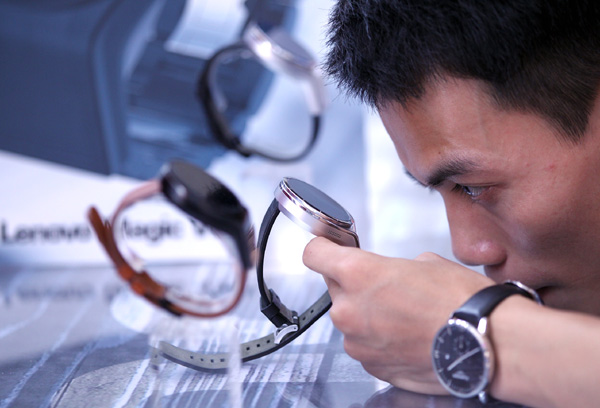
visitor takes a close look at the smartwatch unveiled by Lenovo Group Ltd in Beijing, May 28, 2015. (Photo/China Daily)
The 13th Five-Year Plan (2016-20) has made it clear that consumption will play a "fundamental role" and investment a "key role" in China's economic growth.
Investment and consumption help maintain a country's economic growth and social stability. Consumption has been the basic driver of economic growth, while investment, determines a country's development stage and level.
In this context, developed countries' experience reveals certain development patterns. When a country's per capita GDP is comparatively low, the investment rate is correspondingly low and consumption rate high.
But when a country's GDP reaches a certain level, a stage at which it can meet people's basic needs of food and clothing, its urgent task is to achieve industrialization. This stage sees large-scale infrastructure construction, investment in enterprises and urbanization projects, which increase the investment rate but bring down the consumption rate.
In the third stage, when a country's industrialization, urbanization and modernization are basically complete and it enters the developed stage, its investment market becomes basically saturated and its investment rate declines. This signifies a relatively stable state when the consumption rate stabilizes too.
The changes in China's investment and consumption rates since the launch of reform and opening-up conform to this rule.
Normally, investments, consumption and exports together drive a country's economic growth. But now that China has embraced a "new normal" of sustainable development, the roles of the three growth drivers are gradually changing.
The growth rates of China's imports and exports have declined because of both domestic and external factors. General Administration of Customs statistics show that since 2012 China's import and export growth has dropped to single digit. From January to September this year, China's imports and exports declined 7.9 percent year-on-year. In the short term, it is difficult to reverse this declining trend.
Therefore, we have to depend on consumption and investment to maintain growth above 6.5 percent. In fact, consumption has already become the main driver of China's economic growth. Data from the National Bureau of Statistics show that consumption contributed 58.4 percent to the total GDP growth in the first three quarters of this year.
Again, from January to October, fixed-asset investment nationwide (excluding rural households) was 44.74 trillion yuan ($6.99 trillion), a year-on-year growth of 10.2 percent. During the same period, total retail sales of consumer goods was 24.44 trillion yuan, registering a year-on-year growth of 10.6 percent. This proves that the growth rates of investment and consumption have been almost equal.
In contrast, from 1979 to 2014, China's annual investment growth rate was about 20 percent, while the annual consumption growth rate was 10.6 percent, or just more than half of the investment growth rate.
Investment and consumption are not mutually exclusive. Instead they are closely related. Investment growth will create more jobs, and increase incomes and consumption, whereas consumption growth will reduce enterprises' inventory and expand the market.
That consumption has become a major driver of growth is a sign that China's economic restructuring is progressing well. If the consumption growth rate remains low for a long time, it will create an imbalance in the ratio of investment and consumption, which in turn will affect investment growth and result in excessive production capacity. That's why the government has been trying to not only boost consumption but also adjust of investment structure.
President Xi Jinping recently said China will deepen the structural reform of the supply side and improve the quality and efficiency of the supply system. The reform of the supply side is a new term that indicates the government understands the importance of balancing rising demand with the supply side's reform.
But there is structural imbalance between China's investment and consumption. There has been excessive supply of traditional middle- and low-end consumer goods and their prices have continuously declined, while there is a shortage of high-quality consumption goods that people have to buy abroad or through the Internet. Also, traditional industries are grappling with the problem of excessive production capacity.
All these indicate that the imbalance between investment and consumption is the biggest hurdle on China's road to sustainable growth. This is a major problem China has to solve during the 13th Five-Year Plan period.
The author, Han Qi, is a professor at the School of International Trade and Economics, University of International Business and Economics, Beijing.


















































